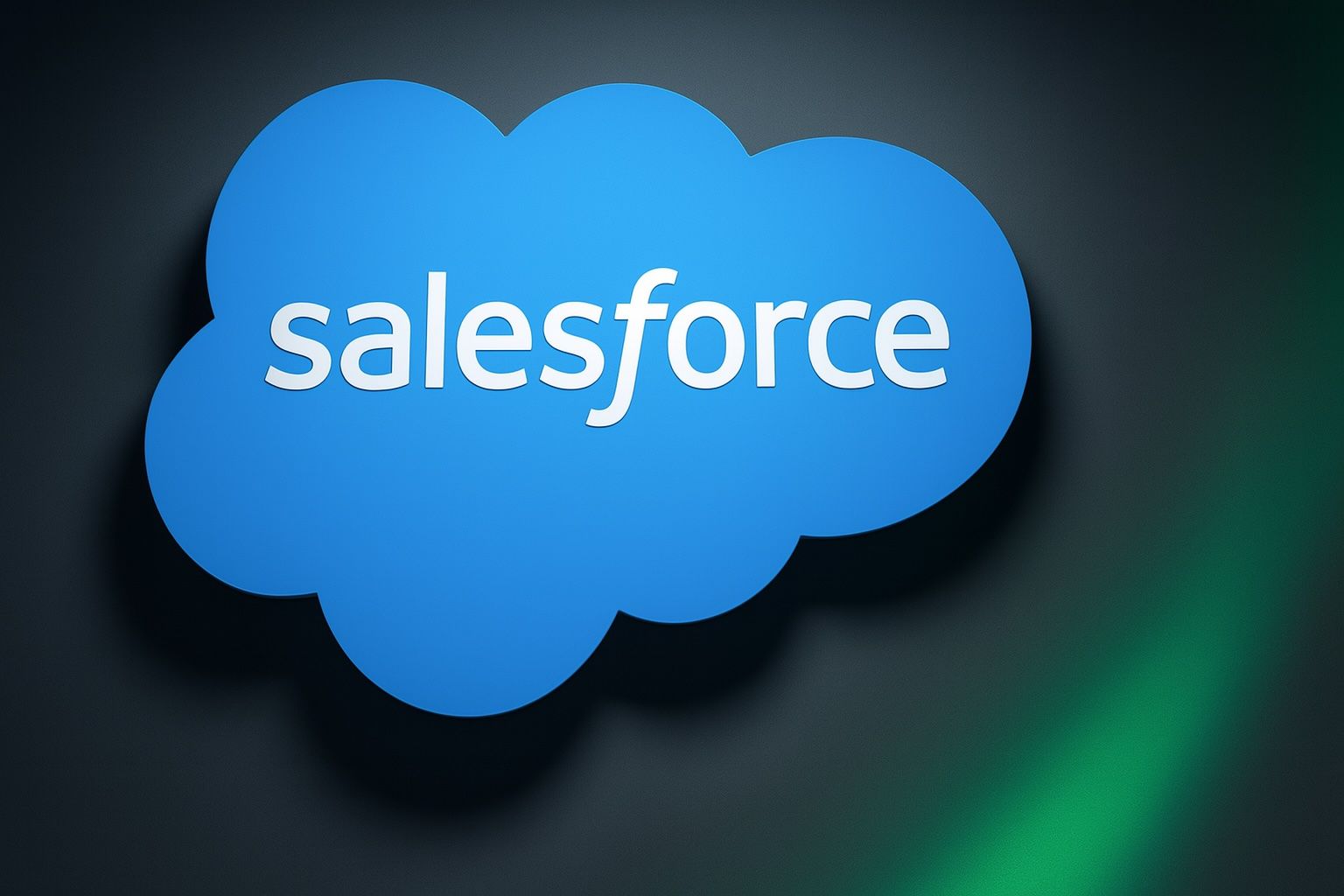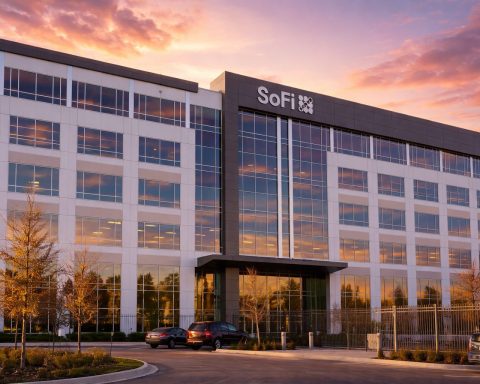What to Know Before Markets Open on October 20, 2025
- Stock Rebound: Salesforce (NYSE: CRM) shares jumped nearly 4% this week, trading around the mid-$240s on Friday after the company unveiled an upbeat 2030 outlook. Even after this bounce, CRM remains down roughly 27–29% year-to-date in 2025 [1], sharply underperforming the broader market and tech peers.
- Big AI Ambitions: At its Dreamforce 2025 event, Salesforce announced a bold new revenue target of over $60 billion by FY2030, topping Wall Street’s ~$58 billion consensus [2]. The company rolled out major AI-driven features – launching its “Agentforce” platform of AI agents and integrating generative AI across products (from Slack chatbots to voice assistants) – part of a push to make AI ubiquitous in Salesforce’s tools [3]. An expanded OpenAI/Anthropic partnership will bring GPT-4 and Claude models into Salesforce’s platform, which executives hail as the start of an “agentic AI era” [4].
- Recent Headwinds vs. Fresh Optimism: A soft sales outlook last quarter sent CRM stock to multi-month lows near ~$235 in early October [5]. Now, however, new AI optimism is lifting sentiment. Salesforce’s upbeat long-term guidance has investors hoping growth will reaccelerate, though caution persists. Wall Street’s 12-month price targets range widely from roughly $221 up to $405 [6] – reflecting bulls who foresee AI-driven growth upside, and bears wary of near-term execution risks.
- Context – Competition and Rates: High interest rates and cautious IT spending in 2025 have weighed on cloud software stocks, including Salesforce [7]. Meanwhile, rivals have surged: Oracle’s stock has nearly doubled this year on big AI cloud deals, and Microsoft is up about 20% thanks to its AI lead [8]. Salesforce’s valuation now looks relatively cheap (~20× forward earnings vs ~31× for Microsoft/Oracle) [9], suggesting that if Salesforce can reignite growth, its stock could see outsized gains.
- Technical Picture: Despite the recent uptick, CRM shares remain below key technical levels. The stock is still trading under major moving averages and well off its 52-week high (in the upper $200s). As one analysis noted, breaking above these resistance levels could “trigger a rapid influx of capital” into the stock [10] – but for now, momentum is unproven. Traders are looking for confirmation that this rally can sustain beyond a one-week pop.
Rocky 2025 for CRM Stock
Salesforce’s stock has been on a rollercoaster ride through 2025. Early in the year, shares rallied on AI hype, but momentum fizzled as growth remained modest. A steep sell-off hit in September after Salesforce issued cautious revenue guidance for the fall quarter, which rattled investors and knocked CRM to its lows for the year [11] [12]. In fact, Salesforce’s Q3 FY2026 outlook (for the Aug–Oct 2025 quarter) projected only ~8–9% revenue growth – barely inline with estimates – triggering an immediate sell-off. The stock plunged about 5% on September 3 (post-earnings) and another ~8% on September 4 as traders digested the lackluster guidance [13]. This one-two punch drove CRM down into the mid-$230s, its lowest levels in months and far below its late-2021 highs (near $370). The message was clear: heavy investments in AI had yet to translate into the reaccelerated growth Wall Street hoped for [14].
Notably, this drop came despite solid core results in the prior quarter. Salesforce’s fiscal Q2 (July 2025 quarter) beat expectations with $10.2 billion in revenue (+10% YoY) and expanding profit margins. CEO Marc Benioff even hailed it as an “outstanding quarter,” noting the company was on track for a record ~$15 billion in annual operating cash flow [15]. Salesforce has now delivered ten consecutive quarters of margin improvement. It also returned $2.6 billion to shareholders in the first half of the year and boosted its share buyback program by a massive $20 billion to take advantage of the depressed share price [16]. However, the tepid Q3 forecast overshadowed those positives. Investors grew uneasy that even after big acquisitions and product launches, Salesforce’s revenue growth was stuck around ~10% and not yet inflecting higher.
Mid-October brought a turnaround in market sentiment. As Salesforce’s annual Dreamforce conference and investor briefing arrived, the stock stabilized in the mid-$230s and then spiked on October 16 when upbeat long-term news hit the wire [17]. Salesforce’s management projected much rosier horizons (more on this below), sparking a nearly 4% one-day jump that lifted CRM to about $246 by Thursday’s close (Oct 16) [18]. Even after pulling back slightly to ~$243 into the weekend, the stock’s weekly gain was a relief to long-suffering shareholders. Still, CRM remains down roughly 27%–29% in 2025 [19], dramatically lagging the S&P 500 and most big tech names. Salesforce has underperformed the S&P by over 30 percentage points in the past year [20] – a stark reversal from its high-flying days. This backdrop helps explain why the latest rally, while encouraging, is met with both hope and skepticism.
On a technical basis, Salesforce has yet to break out of its downtrend. The stock continues to trade below major moving averages (key trend indicators) and well beneath its year-to-date highs (upper $200s). Analysts note that only a decisive move above these resistance levels would confirm a true trend reversal – potentially “trigger[ing] a rapid influx of capital” from sidelined investors [21]. In other words, CRM is off the canvas but not out of the woods. Its beta of ~1.2 means the stock is more volatile than the market, often swinging harder on both up and down days [22]. That volatility cuts both ways: good news can spur outsized gains, but bad news can do the opposite. With bulls and bears now locked in a tug-of-war, all eyes are on whether Salesforce can deliver enough upside surprises to sustain this nascent rebound.
Big AI Bets and Ambitious Targets
The catalyst for Salesforce’s mid-October bounce was a wave of major announcements showcasing the company’s all-in bet on artificial intelligence. At Dreamforce 2025 (Salesforce’s annual tech conference) and an investor day on October 15, CEO Marc Benioff and his team laid out a vision to reignite growth via AI. The headline revelation: Salesforce is now forecasting over $60 billion in annual revenue by FY2030, significantly above previous estimates (~$58B) [23]. This ambitious 2030 target sent a strong signal that management believes its heavy investment in AI will pay off in spades. Investors cheered the news – Salesforce “just delivered the growth story Wall Street’s been craving,” as one tech outlet put it [24]. CRM shares spiked ~5% in after-hours trading when the long-term outlook was unveiled [25].
Driving that optimism is Salesforce’s aggressive rollout of new AI products and features across its platform. In 2025, Salesforce has doubled down on generative AI upgrades for its entire Customer 360 software suite. A centerpiece is Agentforce 360, a framework of “autonomous AI agents” that Salesforce is embedding into its sales, service, marketing, and analytics apps. Unveiled globally at Dreamforce, Agentforce is designed to automate routine tasks and act as a “digital co-worker” alongside human users [26]. “We are truly in the agentic AI era,” declared Salesforce co-founder and CTO Parker Harris at the event, predicting that “40% of the work in the Fortune 1000 is probably going to be done by AI… with humans and AI working together” [27]. That bold vision underpins Salesforce’s strategy: infuse AI into every workflow so customers become more productive – and more reliant on Salesforce’s ecosystem.
To make this a reality, Salesforce announced a slew of AI integrations and partnerships. In a landmark deal with OpenAI, Salesforce will let users access Agentforce AI tools directly within ChatGPT, OpenAI’s popular chatbot [28]. For example, a sales rep could ask ChatGPT (with enterprise safeguards) to pull up Salesforce customer data or draft a proposal, all through natural language prompts. Meanwhile, Salesforce’s own Slack messaging app is being transformed into a new AI-driven interface for work: Slack will host “AI assistant” bots that can answer employee questions or update records in real time. The company even introduced Agentforce Voice, an AI assistant that can talk to customers over the phone – handling basic support calls or sales inquiries and handing off to humans when needed [29]. In e-commerce, a new “Instant Checkout” AI agent (built with OpenAI and Stripe’s protocols) aims to let customers complete purchases via chat in a single step [30]. Across the board, Salesforce is weaving AI into its products in ways that were the stuff of science fiction just a couple years ago.
Salesforce is also expanding its AI ecosystem through big-ticket acquisitions and investments. Notably, the company announced in May 2025 an $8 billion deal to acquire Informatica, a leading data management and integration firm [31] [32]. Incorporating Informatica’s advanced data tools will bolster Salesforce’s Data Cloud and improve the quality and governance of data feeding its AI models. (Salesforce’s $60B revenue forecast notably excludes any boost from the pending Informatica acquisition [33], indicating the target is based on organic growth plus already-closed deals.) Salesforce has also snapped up smaller AI startups – e.g. workflow automation firm Regrello (announced Aug 2025) and UK-based Convergence.ai – to plug any gaps in its platform [34]. These moves reflect Benioff’s playbook of using M&A to quickly obtain new capabilities (similar to past buys like Slack, Tableau, and MuleSoft). However, such aggressive deal-making isn’t without controversy: industry analysts like Rebecca Wettemann have warned that too many acquisitions without clear growth payoffs could invite activist investors to push for changes [35]. For now, though, Salesforce’s focus is on leveraging all these pieces – new AI features, data integrations, and partnerships – to drive a new cycle of growth.
Crucially, Salesforce isn’t just chasing growth at all costs; it’s also emphasizing profitability and shareholder returns alongside its AI push. At the investor briefing, executives outlined a “Profitable Growth” plan dubbed “50 by FY30” – aiming to reach a 50% operating margin by 2030 (on a non-GAAP basis) [36]. That is roughly double Salesforce’s current margins (in the mid-20s percent) and on par with the most efficient enterprise software firms. Achieving it will require disciplined cost control and high-margin AI revenue streams. To underline their confidence, Salesforce’s board authorized a new $7 billion accelerated stock buyback over the next six months [37] – essentially betting that the current stock price is a bargain. (This is part of a larger repurchase boost that brought the total buyback authorization to $20 billion [38].) Such shareholder-friendly moves signal that Salesforce’s leadership believes better days lie ahead. Indeed, CFO Robin Washington – who was elevated this year to oversee operations and finance – asserted at Dreamforce that “we have had some lower-stage growth for a while… that is reaccelerating”, pushing back on worries of stagnation [39]. The combination of bold AI innovation and promises of higher margins has, at least for now, started to mend some of the rift in investor sentiment.
Wall Street’s Verdict: Bulls vs. Bears
On Wall Street, the reaction to Salesforce’s AI-fueled revival plan has been cautiously optimistic – but divided. Many analysts see significant upside if Salesforce can execute on its vision, while others remain skeptical until proof of faster growth emerges. The consensus 12-month price target for CRM sits around $330 per share, roughly 35% above the current trading level [40]. That average reflects a wide spectrum of views. On the bullish end, some prominent analysts have issued eye-popping targets and exuberant commentary following Dreamforce. For instance, JMP Securities recently reaffirmed an Outperform rating with a Street-high $430 target [41] – implying the stock could nearly double. Wedbush’s tech guru Dan Ives, a noted bull on AI stocks, likewise maintained an Outperform and upped his target to the mid-$300s (around $375). Ives believes Salesforce’s aggressive AI momentum will “enter a new gear” heading into 2025 [42], helping reaccelerate growth and sentiment. Other optimists, including analysts at Needham and Cantor Fitzgerald, have Buy ratings and price forecasts in the $325–$400 range [43], arguing that CRM is significantly undervalued given its market leadership and the long-term boost AI features could add.
Not everyone on the Street is convinced, however. Several analysts are staying on the sidelines and keeping more conservative outlooks until they see harder evidence of an upswing. Both Macquarie and D.A. Davidson, for example, reiterated “Neutral” ratings on Salesforce in mid-October [44]. Their cautious price targets (roughly $225–$250) suggest little upside from current levels. These skeptics point out that Salesforce’s growth has only been ~10–11% in recent quarters [45] – a far cry from the heady 20%+ growth of its past – and that monetizing the new AI products may take time [46]. Indeed, while customers are intrigued by Salesforce’s AI demos, enterprises may be slow to roll out these tools at scale given economic uncertainties. RBC Capital Markets has noted that initial investor enthusiasm around the Agentforce AI platform “has moderated” as many clients are still just experimenting with AI rather than deploying it broadly [47]. In other words, there’s plenty of hype, but the revenue from AI features (often sold as paid add-ons) is still in its early days. Skeptics want to see Salesforce prove that its big AI investments will tangibly boost the top line, not just generate buzz.
Overall, the balance of analyst sentiment leans positive, but with a clear acknowledgement of risks. According to StockAnalysis.com data, about 30+ analysts cover CRM and the vast majority rate it a Buy or Outperform [48]. The median price target in the low-to-mid $300s implies significant upside if Salesforce’s strategy works. Bulls argue that the stock’s valuation discount (20× forward earnings vs ~31× for peers) [49] gives investors a favorable risk/reward — essentially a margin of safety — as long as Salesforce can even modestly accelerate growth. They also point to Salesforce’s dominant market position (still the #1 CRM platform globally with ~24% share, larger than the next four competitors combined) and its improving efficiency as reasons to be confident in the long run. Bears and neutrals counter that the company’s size makes high growth harder, that competition in cloud software is only getting fiercer, and that the current economic climate is not exactly ripe for big enterprise software spending sprees. With interest rates high and many companies tightening IT budgets, even a best-in-class firm like Salesforce might struggle to re-ignite double-digit growth in the near term [50]. This tug-of-war between long-term optimism and short-term caution is evident in the spread between high and low analyst targets – and it mirrors the mixed feelings within Salesforce’s shareholder base.
Competitive Landscape and Industry Context
Zooming out, Salesforce’s fortunes in late 2025 are tightly intertwined with the broader enterprise tech landscape – from the moves of rivals to the macroeconomic backdrop. One factor weighing on Salesforce (and many cloud/software stocks) this year has been the rising interest rate environment and macroeconomic uncertainty. As Oppenheimer’s analysts noted, Salesforce’s recent outlook reflects a “tough macro environment” for front-office software providers [51]. Around the world, companies have become more cautious on spending amid inflation and recession worries, often deferring large software projects or demanding clearer ROI on AI initiatives [52]. This has dampened growth for even AI-hyped vendors – Salesforce included. It’s a classic irony: even as Salesforce launches cutting-edge AI tools, some customers are pulling back on budgets in the near term [53]. The result is that Salesforce’s revenue growth has decelerated from the mid-teens a few years ago to high single-digits now, despite the technological leaps.
Meanwhile, competition in the cloud and AI arena is as intense as ever. Salesforce remains the global leader in customer relationship management software, and its diverse product portfolio (spanning sales, service, marketing, e-commerce, analytics and more) gives it a formidable platform. But tech giants like Microsoft, Oracle, and SAP are determined not to cede ground. Oracle, in particular, has enjoyed a stock renaissance in 2025 by positioning itself as a go-to cloud for AI workloads – its shares have nearly doubled this year [54] on the back of high-profile AI cloud infrastructure deals. Microsoft, Salesforce’s frenemie in many areas, has also outperformed – its stock is up about 20% in 2025 [55], aided by its early lead in integrating AI (think ChatGPT features in Office, and Azure’s tie-ups with OpenAI). By contrast, Salesforce’s stock sagged for most of the year, making it something of an outlier among big tech. This divergence has left Salesforce looking undervalued relative to peers: at around 20× forward earnings vs 30×+ for Microsoft and Oracle [56], investors are essentially pricing in lower expectations for Salesforce’s future growth. The silver lining is that if Salesforce proves those expectations too low – say, if its AI investments drive an unexpected surge in sales next year – the stock could play “catch up” in a big way.
It’s also worth noting that Salesforce’s push into generative AI comes as virtually every enterprise tech provider is touting AI capabilities, leading to a bit of an “AI arms race.” Beyond the usual suspects, upstart competitors leveraging AI are cropping up in various niches of the CRM and marketing tech space. Salesforce is responding by using its huge war chest (over $14 billion in net cash on hand [57]) to invest in talent and infrastructure globally. The company recently announced plans to invest $6 billion in the UK by 2030 to establish a major AI research hub there [58], part of a broader effort to attract AI researchers and shape the direction of enterprise AI. As Morningstar’s Dan Romanoff observed, the industry is already seeing a shortage of AI talent, so Salesforce’s heavy investment in people and R&D “makes sense” [59] as a long-term play – but it’s not a quick fix. In the near term, Salesforce will have to battle both external headwinds and well-funded competitors as it seeks to turn its AI vision into tangible results.
Investor Sentiment and Outlook
Looking ahead, investor sentiment on Salesforce remains mixed, balancing optimism about the long run against caution about the next few quarters. The stock’s September tumble and October rebound encapsulate this split mood. Bulls argue that Salesforce is at the forefront of a new AI-driven growth cycle: the company’s massive customer base and rich data troves give it a unique advantage in rolling out AI features at scale. If even a fraction of Salesforce’s clients adopt its new AI products (and pay extra for them), it could unlock a significant new revenue stream over the next 1–2 years. Moreover, Salesforce’s commitment to improving profitability (e.g. the 50% margin target) and returning cash via buybacks provides a solid buffer for investors – the company isn’t just chasing growth, it’s also minding the bottom line and shareholder value. In their best-case scenario, bulls see CRM stock not only recovering its 2025 losses but eventually climbing to new heights if AI truly boosts Salesforce’s sales growth back into double digits. The fact that management raised its long-term outlook and is putting money behind its confidence (via share repurchases) reinforces the bullish view that “better days are ahead.”
Bears and skeptics, on the other hand, emphasize the “show me” aspect of this story. Yes, Salesforce has outlined an exciting vision, but executing it is the hard part. They note that enterprise customers can be slow to change – many firms are still testing AI in pilot programs and are wary of trusting critical customer interactions entirely to algorithms [60]. There is also the question of competition: if every CRM and software vendor is offering similar AI tools, will Salesforce be able to maintain pricing power and uniqueness? The company’s decision to acquire multiple firms (Informatica, etc.) to bolster its AI and data capabilities could introduce integration risks, and it has caught the attention of some activist investors who prefer more focus and organic growth [61]. Additionally, macroeconomic risks persist; if interest rates remain elevated or if a recession hits, businesses might further cut back spending on software upgrades, delaying Salesforce’s AI payoff. Skeptics thus see Salesforce’s rosy 2030 target as far from guaranteed – they want to see the next couple of earnings reports show clear evidence that growth is meaningfully accelerating above the high-single-digit rut.
The next major milestone for investors will be Salesforce’s Q3 FY2026 earnings report, expected in late November 2025. That release will show whether the company’s August–October results picked up at all (perhaps from early AI-related demand or year-end budgeting by clients) and how its guidance for the final quarter and early 2026 looks. Any upside surprise in growth or a more upbeat short-term outlook could give the stock a further jolt, validating those who have bought into the AI vision. Conversely, if results come in only inline and the outlook remains muted, we could see another pullback as “the guidance [gives] bears fresh ammo,” to quote one analyst [62]. In the meantime, expect Salesforce to keep up a steady drumbeat of AI news, customer case studies, and possibly additional partnership announcements to sustain enthusiasm.
Bottom Line: Salesforce, Inc. is attempting a tricky but potentially rewarding transformation – evolving from a cloud software heavyweight into an AI-powered growth engine. Its stock has been punished in 2025 amid slowing growth and skeptical investors, but the latest AI-fueled initiatives and optimistic 2030 goal have sparked new hope. CRM stock’s jump in mid-October indicates that many see compelling value in Salesforce at current levels, especially relative to peers, if the company can turn its AI bets into real-world revenue and profit gains. It won’t happen overnight: as Salesforce’s own leaders admit, this is a multi-year journey. In the coming months, the tug-of-war between bulls and bears will likely continue to play out in the share price. For now, Salesforce has given investors a glimpse of a more dynamic future – and the market’s verdict in the next few quarters will reveal if that future is arriving fast enough.
Sources: Salesforce Investor Day announcements and Dreamforce highlights; TS2.tech analysis and market commentary [63] [64] [65] [66]; Reuters and Bloomberg news reports on Salesforce’s outlook and market conditions [67] [68]; Expert analyst quotes via TS2.tech and financial media (Wedbush, RBC, Oppenheimer, JPMorgan) [69] [70] [71]; Salesforce’s financial results and filings for Q2 FY2026 [72] [73].
References
1. ts2.tech, 2. ts2.tech, 3. ts2.tech, 4. ts2.tech, 5. ts2.tech, 6. ts2.tech, 7. ts2.tech, 8. ts2.tech, 9. ts2.tech, 10. ts2.tech, 11. ts2.tech, 12. ts2.tech, 13. ts2.tech, 14. ts2.tech, 15. ts2.tech, 16. ts2.tech, 17. ts2.tech, 18. ts2.tech, 19. ts2.tech, 20. ts2.tech, 21. ts2.tech, 22. ts2.tech, 23. ts2.tech, 24. ts2.tech, 25. ts2.tech, 26. ts2.tech, 27. ts2.tech, 28. ts2.tech, 29. ts2.tech, 30. ts2.tech, 31. ts2.tech, 32. ts2.tech, 33. ts2.tech, 34. ts2.tech, 35. ts2.tech, 36. ts2.tech, 37. ts2.tech, 38. ts2.tech, 39. ts2.tech, 40. ts2.tech, 41. ts2.tech, 42. ts2.tech, 43. ts2.tech, 44. ts2.tech, 45. ts2.tech, 46. ts2.tech, 47. ts2.tech, 48. ts2.tech, 49. ts2.tech, 50. ts2.tech, 51. ts2.tech, 52. ts2.tech, 53. ts2.tech, 54. ts2.tech, 55. ts2.tech, 56. ts2.tech, 57. ts2.tech, 58. ts2.tech, 59. ts2.tech, 60. ts2.tech, 61. ts2.tech, 62. ts2.tech, 63. ts2.tech, 64. ts2.tech, 65. ts2.tech, 66. ts2.tech, 67. ts2.tech, 68. ts2.tech, 69. ts2.tech, 70. ts2.tech, 71. ts2.tech, 72. ts2.tech, 73. ts2.tech







